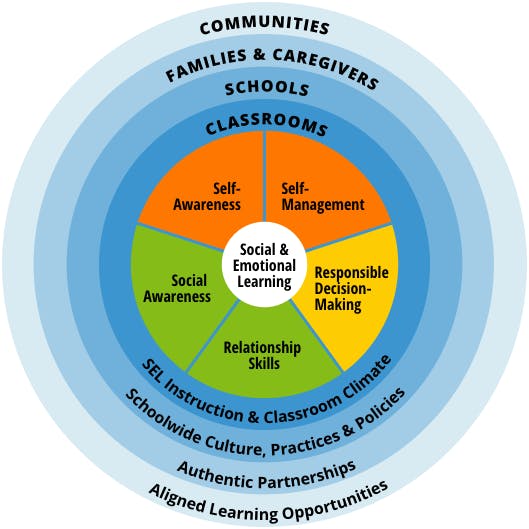There’s been a lot of conversation lately about social-emotional learning, or SEL — but the term isn’t always clearly defined. So with help from OCDE’s Educational Services team, let’s take a closer look at what SEL is, how it works in schools, and what it’s not.
What is SEL?
Social and emotional learning refers to the process through which students and adults develop the skills to manage emotions, build positive relationships and make responsible decisions. These include competencies like self-awareness, self-management, social awareness, relationship skills and decision-making — all of which contribute to success in school, work and life.
The term itself was first coined in 1994 with the creation of the Collaborative for Academic, Social, and Emotional Learning, or CASEL, a national organization that works to translate SEL research into practical tools for schools.
CASEL’s widely used framework highlights five core competencies supported by schools, families and communities. These are outlined on the CASEL website, along with a graphic known as the CASEL wheel.

Is SEL new?
No. While the term may be newer to some, social and emotional learning has been part of education research and practice for decades. Studies over the past 30 years have found that effective SEL programs can support student engagement, reduce behavioral issues and contribute to academic success.
For example, research shows that students in SEL programs scored an average of 11 percentile points higher on academic achievement tests than their peers.
Is SEL the same as therapy?
No. SEL is not therapy. It is classroom-based instruction that helps students build practical skills — similar to how they might learn about nutrition or exercise in health classes.
SEL supports positive mental health by fostering safe relationships, emotionally supportive environments and coping skills. But it’s distinct from clinical mental health services, which are provided by licensed professionals.
Does SEL take time away from academics?
Many educators say SEL supports — rather than detracts from — learning. When students can manage stress, work collaboratively and stay focused, they’re more likely to succeed in academic settings.
In practice, SEL is often integrated into existing lessons, routines and interactions rather than taught as a standalone subject. Schools may also embed SEL into schoolwide practices and expectations.
Is SEL political?
No. SEL is not designed to promote a political ideology. Local school boards, administrators and educators make decisions about how to implement SEL based on the needs and goals of their communities.
The skills emphasized in SEL — such as empathy, collaboration and communication — are intended to help students succeed in diverse settings, including classrooms, workplaces and communities.
A 2022 survey by the National PTA found that more than three-quarters of parents supported schools teaching skills like respect, cooperation and perseverance.
A shared responsibility
While families play a primary role in teaching values and life skills, schools also help support social and emotional development. Students come to school with a range of abilities in this area, and schools aim to meet students where they are and help them grow.
When implemented well, SEL can help build school environments where students feel supported and engaged, educators feel equipped, and families feel welcome.
For more information about social and emotional learning, visit casel.org or reach out to your local school district.
